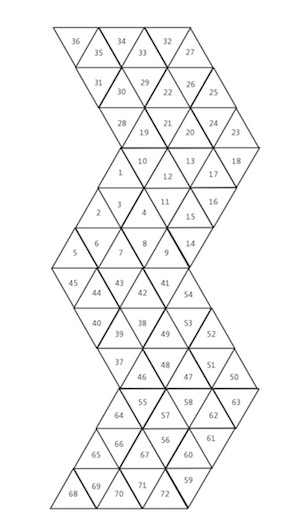HDU 6202 cube cube cube (2017沈阳网赛
来源:互联网 发布:销售数据分析表怎么做 编辑:程序博客网 时间:2024/04/29 06:17
题意:
给你一个八面八轴的魔方, 问你是否 3步内还原。
思路:
真的太恶心的一个题目。。。。
其实理清了 很 简单, 虽然写起来很麻烦。
看题目中的图片描述的话, 底面是可以转的, 且有八个面, 首先就有8种旋转底面的操作。
图中还介绍了旋转中间轴, 中间轴的话 是 两个面确定一个中间轴, 一共8面, 因此有四个中间轴。
因此 有8 + 4 = 12 种旋转操作, 加上逆时针, 一共24种旋转操作。
逆时针也挺好转, 旋转底面的操作的逆时针 就是 顺时针转两次。
中间轴同理, 直接写也挺好写。
然后模拟就行了。
但是一直WA, 本以为是旋转出了问题(确实有问题), 但错误根本还在于 dfs 写错了。
之前一直没注意到dfs 这个问题, 今天也通过这个题 长见识了。。。
那就是dfs里 开临时数组不能太大 太多。
因为是回溯嘛, 所以要记录没转之前是啥, 但是一开就是一个72的int 数组, 直接出不来答案。。。。。(那也应该返回TLE 把。。。)
所以为了避免重复开数组, 直接不开好了, 转过去, 在逆时针转回来好了, 别记录了。。。
贴几幅图纪念一下吧,。。T_T
随便参考一下:
#include <cstdio>#include <cstring>#include <algorithm>using namespace std;int a[100];bool check(){ for (int i = 1; i <= 8; ++i){ int st = (i-1)*9 + 1; for (int j = st; j <= st + 9 - 1; ++j){ if (a[j] != a[st]) return false; } } return true;}int a2[100] ;void rotate1(int b[], int c[]){ int t = a[ b[6] ]; a[b[6] ] = a[b[0] ]; a[b[0] ] = a[b[12] ]; a[b[12] ] = t; int t1 = a[b[1] ]; int t2 = a[b[2] ]; int t3 = a[b[3] ]; int t4 = a[b[4] ]; int t5 = a[b[5] ]; for (int i = 1; i <= 5; ++i){ a[b[i] ] = a[b[ i + 12] ]; } for (int i = 13; i < 18; ++i){ a[b[i] ] = a[b[i - 6] ]; } a[b[7] ] = t1; a[b[8] ] = t2; a[b[9] ] = t3; a[b[10] ] = t4; a[b[11] ] = t5; for (int i = 1; i <= 72; ++i){ a2[i] = a[i]; } a[c[0] ] = a2[c[4] ]; a[c[1] ] = a2[c[6] ]; a[c[2] ] = a2[c[5] ]; a[c[3] ] = a2[c[1] ]; a[c[4] ] = a2[c[8] ]; a[c[5] ] = a2[c[7] ]; a[c[6] ] = a2[c[3] ]; a[c[7] ] = a2[c[2] ]; a[c[8] ] = a2[c[0] ];}void rotate2(int d[], int way){ if (way == 0){ int t1 = a[d[15] ]; int t2 = a[d[16] ]; int t3 = a[d[17] ]; for (int i = 15; i >= 3; i -= 3){ for (int j = i; j < i + 3; ++j){ a[d[j] ] = a[d[j-3] ]; } } a[d[0] ] = t1; a[d[1] ] = t2; a[d[2] ] = t3; } else { int t1 = a[d[0] ]; int t2 = a[d[1] ]; int t3 = a[d[2] ]; for (int i = 0; i <= 12; i += 3){ for (int j = i; j < i + 3; ++j){ a[d[j] ] = a[d[j+3] ]; } } a[d[15] ] = t1; a[d[16] ] = t2; a[d[17] ] = t3; }}///================================/// 1:///0 6 12///23 64 9/// 0 1 2 3 4 5 6 7 8 9 10 11 12 13 14 15 16 17int b1[] = {23, 63, 62, 58, 57, 55, 64, 37, 39, 38, 42, 41, 9, 14, 15, 16, 17, 18};int c1[] = {50, 52, 51, 47, 54, 53, 49, 48, 46};int b2[] = {19, 10, 12, 11, 15, 14, 54, 41, 42, 43, 44, 45, 68, 36, 35, 31, 30, 28};int c2[] = {1, 2, 3, 4, 5, 6, 7, 8, 9};int b3[] = {1, 28, 30, 29, 33, 32, 72, 59, 60, 61, 62, 63, 50, 18, 17, 13, 12, 10};int c3[] = {19, 20, 21, 22, 23, 24, 25, 26, 27};int b4[] = {28, 19, 21, 20, 24, 23, 63, 50, 51, 52, 53, 54, 41, 9, 8, 4, 3, 1};int c4[] = {10, 11, 12, 13, 14, 15, 16, 17, 18};//////////aaaaint b5[] = {37, 46, 48, 47, 51, 50, 18, 23, 24, 25, 26, 27, 32, 72, 71, 67, 66, 64};int c5[] = {55, 56, 57, 58, 59, 60, 61, 62, 63};int b6[] = {45, 68, 69, 70, 71, 72, 59, 27, 26, 22, 21, 19, 10, 1, 3, 2, 6, 5};int c6[] = {36, 31, 35, 34, 28, 30, 29, 33, 32};int b7[] = {36, 5, 6, 7, 8, 9, 14, 54, 53, 49, 48, 46, 55, 64, 66, 65, 69, 68};int c7[] = {45, 40, 44, 43, 37, 39, 38, 42, 41};int b8[] = {5, 45, 44, 40, 39, 37, 46, 55, 57, 56, 60, 59, 27, 32, 33, 34, 35, 36};int c8[] = {68, 70, 69, 65, 72, 71, 67, 66, 64};///=======================///******** 0 1 2 3 4 5 6 7 8 9 10 11 12 13 14 15 16 17int d1[] = {13, 17, 16, 52, 53, 49, 38, 39, 40, 65, 69, 70, 34, 33, 29, 22, 21, 20};int d2[] = {13, 12, 11, 4, 8, 7, 43, 44, 40, 65, 66, 67, 56, 60, 61, 25, 24, 20};int d3[] = {58, 62, 61, 25, 26, 22, 29, 30, 31, 2, 6, 7, 43, 42, 38, 49, 48, 47};int d4[] = {2, 3, 4, 11, 15, 16, 52, 51, 47, 58, 57, 56, 67, 71, 70, 34, 35, 31};void r1(){ rotate2(d1, 0);}void r2(){rotate2(d1, 1);}void r3(){rotate2(d2, 0);}void r4(){rotate2(d2, 1);}void r21(){rotate2(d3, 0);}void r22(){rotate2(d3, 1);}void r23(){rotate2(d4, 0);}void r24(){rotate2(d4, 1);}void r5(){rotate1(b1, c1);}void r6(){rotate1(b1, c1);rotate1(b1, c1);}void r7(){rotate1(b2, c2);}void r8(){rotate1(b2, c2);rotate1(b2, c2);}void r9(){rotate1(b3, c3);}void r10(){rotate1(b3, c3);rotate1(b3, c3);}void r11(){rotate1(b4, c4);}void r12(){rotate1(b4, c4);rotate1(b4, c4);}void r13(){rotate1(b5, c5);}void r14(){rotate1(b5, c5); rotate1(b5, c5);}void r15(){rotate1(b6, c6);}void r16(){rotate1(b6, c6); rotate1(b6, c6);}void r17(){rotate1(b7, c7);}void r18(){rotate1(b7, c7); rotate1(b7, c7);}void r19(){rotate1(b8, c8);}void r20(){rotate1(b8, c8); rotate1(b8, c8);}///=========================================bool dfs(int d){ if (d > 3) return false; if (check()) return true; ///******************* r1(); if (dfs(d+1)) return true; r2(); ///******************* ///******************* r2(); if (dfs(d+1)) return true; r1(); ///******************* ///******************* r3(); if (dfs(d+1)) return true; r4(); ///******************* ///******************* r4(); if (dfs(d+1)) return true; r3(); ///******************* ///******************* r5(); if (dfs(d+1)) return true; r6(); ///******************* ///******************* r6(); if (dfs(d+1)) return true; r5(); ///******************* ///******************* r7(); if (dfs(d+1)) return true; r8(); ///******************* ///******************* r8(); if (dfs(d+1)) return true; r7(); ///******************* ///******************* r9(); if (dfs(d+1)) return true; r10(); ///******************* ///******************* r10(); if (dfs(d+1)) return true; r9(); ///******************* ///******************* r11(); if (dfs(d+1)) return true; r12(); ///******************* ///******************* r12(); if (dfs(d+1)) return true; r11(); ///******************* ///******************* r13(); if (dfs(d+1)) return true; r14(); ///******************* ///******************* r14(); if (dfs(d+1)) return true; r13(); ///******************* ///******************* r15(); if (dfs(d+1)) return true; r16(); ///******************* ///******************* r16(); if (dfs(d+1)) return true; r15(); ///******************* ///******************* r17(); if (dfs(d+1)) return true; r18(); ///******************* ///******************* r18(); if (dfs(d+1)) return true; r17(); ///******************* ///******************* r19(); if (dfs(d+1)) return true; r20(); ///******************* ///******************* r20(); if (dfs(d+1)) return true; r19(); ///******************* ///******************* r21(); if (dfs(d+1)) return true; r22(); ///******************* ///******************* r22(); if (dfs(d+1)) return true; r21(); ///******************* ///******************* r23(); if (dfs(d+1)) return true; r24(); ///******************* ///******************* r24(); if (dfs(d+1)) return true; r23(); ///******************* return false;}int main(){ int T; scanf("%d",&T); while(T--){ int cnt = 0; for (int i = 0; i < 8; ++i){ for (int j = 0; j < 9; ++j){ int x; scanf("%d",&x); a[++cnt] = x; } } int ans = dfs(0); if (ans){ puts("YES"); } else puts("NO"); } return 0;}cube cube cube
Time Limit: 6000/3000 MS (Java/Others) Memory Limit: 327680/327680 K (Java/Others)Total Submission(s): 9313 Accepted Submission(s): 127
Problem Description
Rubick has a strange cube. Can you restore Rubik's cube in 3 steps (including 3)?
Rubik's cube is shown in the following picture:

The plane expansion of the Rubik's cube is shown in the following figure, each number represents the color corresponding to each cube.

The following picture explains how to rotate this strange cube. If you still feel confused, you can refer to
http://www.bilibili.com/video/av8452301/?from=search&seid=11750270100959783079 .

Rubik's cube is shown in the following picture:

The plane expansion of the Rubik's cube is shown in the following figure, each number represents the color corresponding to each cube.

The following picture explains how to rotate this strange cube. If you still feel confused, you can refer to
http://www.bilibili.com/video/av8452301/?from=search&seid=11750270100959783079 .

Input
The first line contains an integer T (T≤10 ), the number of test cases.
Each test case consists of 72 integers which correspond to the colors of each location of the Rubik's Cube. Each number represents one color, it's guaranteed that there are exactly 8 colors and each color appears 9 times.
Each test case consists of 72 integers which correspond to the colors of each location of the Rubik's Cube. Each number represents one color, it's guaranteed that there are exactly 8 colors and each color appears 9 times.
Output
For each test case, if you can restore the Rubik's cube in 3 steps, output "YES", else output "NO". (both without quote)
Sample Input
11 1 1 1 1 1 1 1 12 2 2 2 2 2 2 2 23 3 3 3 3 3 3 3 34 4 4 4 4 4 4 4 45 5 5 5 5 5 5 5 56 6 6 6 6 6 6 6 67 7 7 7 7 7 7 7 78 8 8 8 8 8 8 8 8
Sample Output
YES
Source
2017 ACM/ICPC Asia Regional Shenyang Online
Recommend
liuyiding | We have carefully selected several similar problems for you: 6205 6204 6203 6202 6201
阅读全文
0 0
- HDU 6202 cube cube cube (2017沈阳网赛
- hdu 6202 cube cube cube
- hdu 6202 cube cube cube 沈阳区域赛网络赛 (膜拟)
- HDU 6202 cube cube cube(暴力)
- Cube
- cube
- cube
- cube
- Cube
- Cube
- Cube
- Cube
- Cube HDU
- HDU6202 Cube Cube Cube
- hdu 3584 Cube
- hdu 1220 Cube
- hdu 3547 DIY Cube
- hdu 3547 DIY Cube
- 文件查找过滤器
- 性能优化
- feather
- 超强、超详细Redis数据库入门教程
- 使用FastJSON,将对象、数组、JSON串互转
- HDU 6202 cube cube cube (2017沈阳网赛
- 如何在JAVA中设置同心圆
- 浅析数据一致性
- 垃圾回收机制
- ARM中状态转移指令+条件执行+内存操作
- 装饰器学习笔记2:闭包
- 多引脚的编程应用
- Ambari 2.5.2源码编译打包
- 谈谈单元测试之(二):测试工具 JUnit 3



